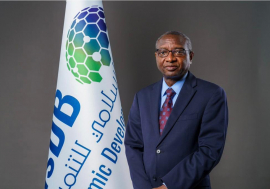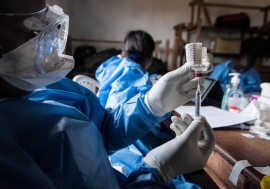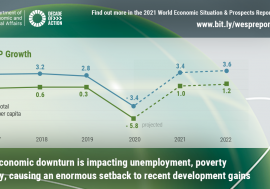Small loans widen horizons for the poor
Small loans widen horizons for the poor
 Signing up for a loan with a community group’s microcredit programme in Kenya.
Signing up for a loan with a community group’s microcredit programme in Kenya.Does microfinance benefit economic development? When asked that question, James Mwangi, chief executive officer of Kenya’s Equity Bank, responds in the affirmative. With even small loans, he told Africa Renewal, “We have seen families graduate from micro-enterprises to semi-medium enterprises.”
Microfinance is a type of lending that targets low-income individuals who may find it difficult to borrow from regular banks because they lack collateral or a credit history. It is not new. Since the 1970s non-governmental groups have given small loans to poor people, especially women and those in the informal sector, to meet basic needs or to start up or expand businesses.
But an increasing number of individual and institutional investors worldwide are putting more money into the sector, reports the Consultative Group to Assist the Poor, (CGAP), a World Bank affiliate that works with governments to expand credit to poor people.
Traditionally, microfinance loans, typically between $20 and $300, were provided by non-governmental organizations (NGOs). Most such groups were not registered as financial institutions, and generally depended on donor funds for the money they lent. That made them vulnerable to changes in donor policies and to rigid rules about the types of projects they could finance.
Then the Grameen Bank in Bangladesh, the first private financial institution to extend microcredit on a large scale, established a new model. Grameen Bank demonstrated that it was possible to extend loans to millions of poor people and still make a profit. It also showed that the poor can be entrepreneurial and creditworthy.
In the last two decades microfinance has grown beyond just lending. According to CGAP, microfinance today refers to “retail banking for poor people” and includes insurance and other services and innovations such as mobile banking.
 Rural women in Senegal sell processed mangos and yams: With just a little credit, poor producers can expand their businesses and incomes.
Rural women in Senegal sell processed mangos and yams: With just a little credit, poor producers can expand their businesses and incomes.The demand has also grown tremendously, far beyond what can be provided with the available financing. A 2007 study by Germany’s Deutsche Bank reported that while $4.4 bn is invested in microfinance worldwide, about $250 bn is actually needed. That demand has made microfinance an attractive option for investors seeking alternative financial instruments that are not tied up with increasingly volatile world financial markets. Such interest has not only made larger loans available, but also has made more credit and financial services available to the poor, especially women (see page 10).
Loan guarantees
Donna Katzin, of the New York–headquartered non-profit funding organization Shared Interest, says that loan guarantees have been one of the more successful innovations in the sector. Shared Interest has followed in the footsteps of the Swiss-based Recherches et Applications de Financements Alternatifs au Développement (RAFAD), which since the 1980s has guaranteed loans that commercial banks issue to microfinance institutions and projects.
By guaranteeing loans, RAFAD and Shared Interest have substantially reduced the risks that commercial banks assume when lending to individuals and groups without credit histories or collateral. The promise implied by the guarantee — that Shared Interest or RAFAD will meet part of the losses if the borrower defaults on the loan — encourages banks not only to make such loans, but also to release more money than they otherwise would. In two decades, RAFAD and its Fonds International de Garantie have issued $53 mn in guarantees on some $212 mn in credits. The funds have created 260,000 small business jobs worldwide, benefiting an estimated 1 million people.
Shared Interest works with RAFAD in South Africa. It has invested $11.4 mn in Thembani Guarantee Trust since 1994. The money earns a return of about 2 per cent in interest.
Being a non-profit, Shared Interest keeps its own returns low. But private lenders often earn more. For most poor borrowers, even interest rates as high as 20–30 per cent are still lower than the exorbitant rates usually charged by loan sharks, often the only other sources of financing where access to commercial banks is limited. Microfinance investors can therefore earn a lot more than through other traditional investments.
A growing sector
Attracted by the potential, private enterprises such as MicroVest, a US private microfinance investment fund, have poured $1 mn into Ghanaian microfinance lender Sanapi Aba Trust. Similarly, AfriCap Microfinance Fund, formed in 2001, has invested in 12 microfinance institutions, including in Ghana, Kenya, Senegal, Madagascar, Malawi, Mozambique, Nigeria and Sierra Leone. AfriCap, which has about $50 mn in capital, was the first Africa-based equity fund to be entirely focused on microfinance.
The results have been significant. The cash injection from AfriCap and Helios International, in exchange for 12 per cent and 25 per cent ownership shares, respectively, in Equity Bank of Kenya, helped turn the formerly small microfinance lender into a major commercial bank. It now serves 2.5 million lower- and middle-income Kenyans. Equity Bank was also able to buy Uganda Microfinance, the biggest microfinance institution in that country. The beneficiaries have been small and medium-scale businesses.
In 2004 Equity Bank became the first African microfinance institution to be publicly traded. By 2006 it had extended loans of more than $106 mn, much of it to women. Its investors have made a tidy profit. “We have seen a 7 per cent return on our assets and grown by 200 per cent,” says Mr. Mwangi.
The growing interest and investment in Africa’s microfinance sector, Mr. Mwangi believes, are largely the result of “dwindling investment opportunities elsewhere.” There is also a “growing recognition that Africa has turned a corner. People are seeing the prospects in Africa, and strategically positioning themselves to take advantage of the continent’s growth.”
Partnerships give hope
With a dual goal of making profits and helping poor people gain access to financial services, private enterprises are increasingly partnering with donor agencies to jointly invest in microfinance. Such partnerships are in line with the 2002 Monterrey Consensus, in which heads of state worldwide agreed on priorities for financing development. Those leaders recognized the importance of microfinance and committed to promote “private-sector financial innovations and public-private partnerships.” Such partnerships, they hoped, would strengthen the capacity of domestic financial institutions to cater to people who have been poorly served, such as rural residents and women. Those two markets, CGAP estimates, account for two-thirds of all microfinance borrowers globally.
One public-private partnership is the GroFin Africa Fund. Worth nearly $150 mn, GroFin is a consortium that includes the African Development Fund, the World Bank’s International Finance Corporation (IFC), Deutsche Bank Foundation Americas, Skoll, Syngenta and the Shell Foundation, among others. The fund plans to invest directly in about 500 small and medium enterprises (SMEs) in Kenya, Tanzania, Uganda, Rwanda, Ghana, Nigeria and South Africa.
GroFin personnel also provide technical assistance to businesses, to help them become more stable and profitable. Combining financing with business advice was a deliberate strategy, Kenneth Onyando, GroFin’s East Africa regional investment manager, stated in 2007. “African SMEs too often struggle to find the capital they need because banks see them as too risky an investment,” he said. “By integrating funding with business development assistance, we are offering a viable solution to this problem — giving SMEs hope and delivering returns to investors.”
Business Partners International (BPI) of Kenya is a similar consortium. It includes the IFC, the European Investment Bank, the East Africa Investment Bank and the Kenyan private equity funds Tran Century and CDC group. BPI set up a $14.1 mn fund in February 2006 and provides loans ranging from $50,000 to $500,000 to its clients. The fund takes collateral when it is available in order to reduce the risk of default. However, when potential borrowers lack collateral, its lending decisions are based on “the viability of the business,” BPI’s chief investment officer, Sally Gitonga, told local media.
Behind schedule
Despite the growing volume of private and donor finance entering the sector in Africa, “microfinance in Africa is at least five years behind schedule, compared to South Asia or Latin America,” Sasidhar Thumuluri, an analyst for MicroVest, told an investment publication. The biggest bottlenecks, he said, are “poor infrastructure, weak institutions, lack of financial and human capital.”
However, he added, “recent positive changes such as establishment of democratic institutions, reverse migration of qualified professionals and improving governance in countries like Ghana are attracting greater investor interest.”
Ms. Katzin notes that for initiatives such as those of Shared Interest to succeed, “there is a need for a formal banking system that has sufficient capital and is able to work with international letters of credit.” Success will be difficult, she told Africa Renewal, “where regulatory environments are not conducive.”
Another concern is default. Ms. Katzin argues that technical assistance is critical for clients experiencing problems, to help them perform better and reduce the risk to investors. By providing such assistance, Shared Interest has kept loan defaults to 3.2 per cent.
To further secure investor money, Shared Interest has also set up a loss reserve fund. “We are not avoiding risk,” says Ms Katzin. “We are managing risk. If people fail to pay, we use our reserve fund to make up for the difference. Until now, no investor has lost a penny of principal.”
Too poor for loans
Not all people are ready for credit, Ms. Katzin acknowledges. Some are so poor that taking out a loan could further mire them in debt and poverty instead of helping. Because such groups are extremely vulnerable, donors must continue to provide support in the form of grants. “There are some countries where you would not recommend a loan scheme, because poverty is so entrenched,” she explains. “In such places, you need grants first, to get people on their feet, before graduating to other forms of capital.”
Mr. Mwangi agrees. “You have to help households meet their livelihood costs first. Then you see children staying in school longer and the health status of the family improving. It is only then that the family can be able to save and also consume more.”
Once a family is able to save, Mr. Mwangi believes, microfinance can then serve to help the family reach higher goals, such as using credit to create and expand an enterprise. “It is at that point that you start having economic growth.”
















